Pharaoh Hound ( Egyptian Pharaoh Hound)
The Pharaoh Hound is a medium-sized breed with a slim, powerful, and athletic build. It is characterized by a blunt wedge-shaped, chiseled skull with slightly long muzzle, oval, amber colored eyes, medium high set ears that are fine, large, and broad at the bottom; a lean, muscular, and long neck, deep chest, long, well laid back shoulders, and a medium set, long, tapering tail with a thick base.
Pharaoh Hound Pictures
- Pharaoh Hound Dog
- Pharaoh Hound Dogs
- Pharaoh Hound Images
- Pharaoh Hound Pictures
- Pharaoh Hound Puppies
- Pharaoh Hound Puppy Pictures
- Pharaoh Hound Puppy
- Pharaoh Hound Size
- Pharaoh Hound
- Pharaoh Hounds
- Pharaohs Hound
- Egyptian Hound Dog
- Egyptian Hound
- Egyptian Pharaoh Hound Puppies
- Egyptian Pharaoh Hound
- Black Pharaoh Hound
Quick Information
| Alternative names | Kelb tal-Fenek (Maltese), Egyptian Hound, Pharaoh dog |
| Coat | Short, glossy, fine, slightly harsh, no feathering |
| Color | Red golden, chestnut, tan, rich tan, black; solid white spot may occur on the shoulders, back, or neck |
| Breed Type | Purebred |
| Group of Breed | Hound, Sighthound |
| Lifespan | 12-14 years |
| Weight | 45-55 lb |
| Size/Height | Medium; male: 23-25 inches female: 21-24 inches |
| Shedding | Little-average |
| Size of Litter | 6-8 puppies |
| Temperament | Intelligent, alert, noble, friendly |
| Hypoallergenic | No |
| Good with Children | Yes |
| Barking | Occasional, high pitched noise |
| Country Originated in | Egypt |
| Competitive Registration/ Qualification Information | AKC, ACA, ACR, APRI, ANKC, DRA, CKC, UKC, NZKC, NAPR, KCGB, FCI, NKC |
Video: Egyptian Pharaoh Hound Learning New Tricks
History
The Pharaoh Hound, an ancient domesticated dog breed, is believed to have originated during 4,000-3,000 BC in Egypt. Its direct ancestors were depicted as hound dogs chasing gazelles in numerous Egyptian writings and artefacts. These ancient hound dogs were also represented as the loyal companions of the members of Egyptian nobility.
The Pharaoh Hounds were brought from Egypt to Malta by the Phoenician traders. As the local Maltese hunters used these dogs for hunting and catching rabbits, the hounds were given the name “Kelb tal-Fenek” meaning “Rabbit dog”.
Imported into England and the US in the 1960s, the Pharaoh Hound Club of America (PHCA) was established in 1970 with the breed gaining official recognition from the American Kennel Club (AKC) in 1983.
Mixes
- Pharaoh Hound/Pitbull Terrier Mix
- Pharaoh Hound/Boxer Mix
- Pharaoh Hound/Basenji Mix
- Pharaoh Hound/Rhodesian Ridgeback Mix
- Pharaoh Hound/Australian Cattle Dog Mix
- Pharaoh Hound/Doberman Pinscher Mix
- Pharaoh Hound/Lab Mix
Temperament and Behavior
The Pharaoh Hound’s remarkable personality can be described as gentle, affectionate, and lovable. It thrives on human companionship and enjoys entertaining people with its clownish antics. Like most hounds, it can be strong-willed and aloof with strangers.
However, a properly socialized Pharaoh dog will get along well with children and other canines. Known to be sensitive by nature, it has the ability to discern its owner’s feelings and can be easily stressed or frustrated.
Although it does not serve well in guarding its family, it will bark and alert its owner whenever it sees or hears anything unusual. It also indulges in barking when its family members are away from the home for long periods.
Care
Exercise
Being a highly energetic dog, the Pharaoh Hound needs a minimum of 30 minutes of daily activity. Apart from training your dog in agility and lure coursing, you can take your Egyptian hound with you on a bike ride or family jog. You can leave your pet in a yard to play, but you will need the fences to be at least six feet high since these sighthounds are excellent jumpers. Do not take a Pharaoh Hound out on wet or cold days, as it gets cold due to its thin skin.
Grooming
Weekly brushing using a rubber mitt or hound glove will remove its loose hairs and prevent them from settling on furniture and clothes. Unless its coat is stinky, you can just wipe it down with a moist cloth. An occasional bath with a dog shampoo will help your Pharaoh dog in looking its best. Its nails tend to grow fast, and thus should frequently be trimmed to avoid splitting and cracking.
Health Problems
Even though these hounds are free from genetic conditions, the breeding stocks are tested for luxating patellas, hip dysplasia, and numerous eye disorders. They are sensitive to anesthetics and may suffer from food-based, contact, and inhalant allergies. In cold climates, their ears are prone to frostbite.
Training
- Introduce your Pharaoh Hound puppy to different experiences, people, and pets so that it can adapt to sudden and unexpected changes. Proper socialization is necessary, as it trains your pet to be well mannered with unfamiliar people and other dogs.
- Cats, rabbits, vermin, or even smaller canines might trigger their strong prey drive. Therefore, the Pharaoh Hound puppies should be taught to walk on a leash. Make sure that you do not yank your pet dog to get it to walk nicely on the lead.
Feeding
An adult Pharaoh Hound should be given one-and-a-half to two cups of dry food per day.
Interesting Facts
- In 1974, it was declared as the national symbol and dog of Malta.
- These dogs exhibit coprophagia, commonly known as feces-eating behavior.
- The Hounds hunt by bouncing in the air, and then landing on all its legs in order to flush out a prey hidden in a mound.
- When excited, the Pharaoh dogs display a distinctive “blushing”, with their nose and ears turning bright pink.
- Some Pharaoh Hound owners train their dogs to “smile”.





















